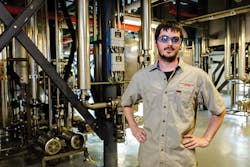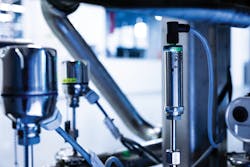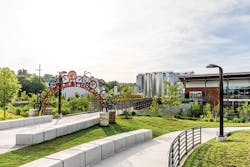Hoppy about Calibration
Self-calibrating thermometer improves operations at New Belgium Brewing
New Belgium Brewing needed an efficient solution to calibrate the brewery’s RTD (resistance temperature detector) thermometers. With almost 100 RTD thermometers installed in the Asheville, N.C., location, the manual calibration process had become time consuming, inefficient, and hazardous.
The brewery currently uses a combination of portable microbaths and other RTD calibrators to perform calibrations on its RTD thermometers. The microbath calibrations involve the use of hot oil and an ITS-90 traceable reference thermometer. Each time the microbath is moved to a new location the oil must be heated to the appropriate temperature and allowed to stabilize prior to performing that actual single-point calibration. Consequently, it takes New Belgium around 45 minutes on average to calibrate each thermometer. With close to 100 RTD thermometers in the facility, performing these calibrations became time consuming, taking up approximately 75 hours per year.
New Belgium’s lead instrumentation specialist Kyle Boughner chose Endress+Hauser’s self-calibrating thermometer to improve brewery operations.
“New Belgium’s willingness to support innovation and modernization allowed me to test the Endress+Hauser iTHERM TrustSens in our process,” said lead instrumentation specialist Kyle Boughner. “After reviewing the product and white papers, I was excited to give this RTD a try.”
Typically, TrustSens is employed as a method of in-situ calibration for processes that undergo sterilize in place (SIP) on a regular basis. As steam is introduced into the process, the temperature passes through the 118°C threshold that triggers the TrustSens calibration. Since New Belgium’s processes do not employ SIP, Boughner has taken a different approach. He employs a simple, portable ceramic block heater in conjunction with TrustSens’s unique technology to perform the single-point calibration. Boughner removes the TrustSens temperature probe from the thermowell and places it in the ceramic block heater. Once the temperature at the RTD exceeds 118°C, TrustSens then begins to cool and automatically initiates the calibration cycle. If the RTD is within New Belgium Brewery’s self-defined accuracy tolerance, a green light appears. Boughner then reinstalls the probe in the thermowell and can proceed to the next RTD.
New Belgium tested the TrustSens thermometer side-by-side against one of the facility’s installed RTD thermometers. Using the ceramic block heater, the calibration of the Endress+Hauser iTHERM TrustSens sensor takes no longer than 15 minutes, resulting in a 30-minute time savings per RTD.
“The iTHERM TrustSens has the capability to turn a very tedious task into an easy and painless process,” said Boughner. “The efficiency gains from this RTD will help free up an enormous amount of time.”
New Belgium tested the TrustSens thermometer side-by-side against one of the facility’s installed RTD thermometers. Using the ceramic block heater, the calibration of the Endress+Hauser iTHERM TrustSens sensor takes no longer than 15 minutes, resulting in a 30-minute time savings per RTD. Replacing the RTDs in the facility with TrustSens could potentially save 80+ hours in calibration time, considering some transmitters are calibrated once a year and others every six months.
New Belgium Brewery’s Asheville, N.C., location.
“The iTHERM TrustSens is trending perfectly with our Endress+Hauser TM411s that we are comparing it to,” said Boughner. “We are not only happy with the ease of calibrations but also with the accuracy and response times we are seeing from this RTD.” IWW
Endress+Hauser is a global leader in measurement instrumentation, services and solutions for industrial process engineering. To learn more, visit www.us.endress.com/New-Belgium-Brewery or visit Booth 16115 at the Craft Brewers Conference.
Circle No. 151 on Reader Service Card



